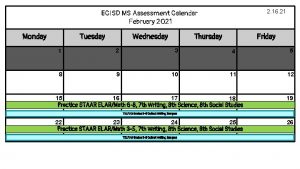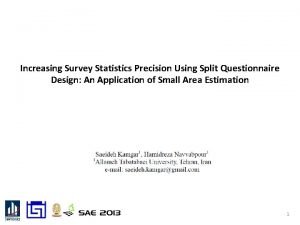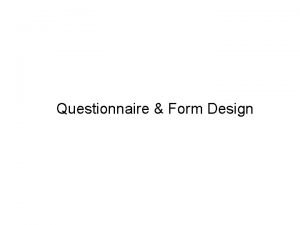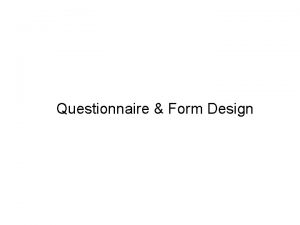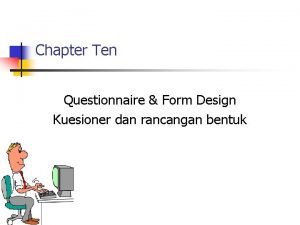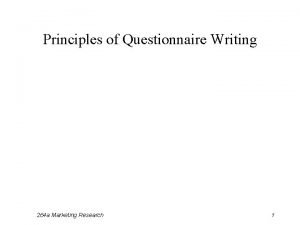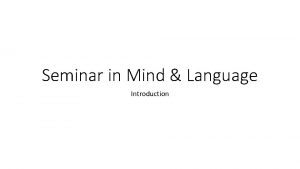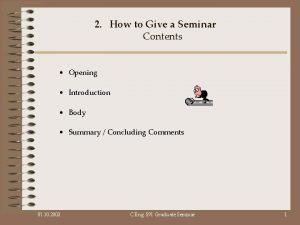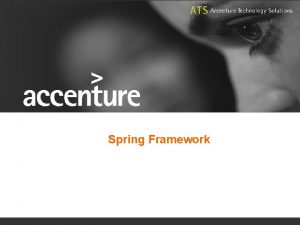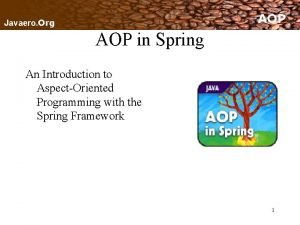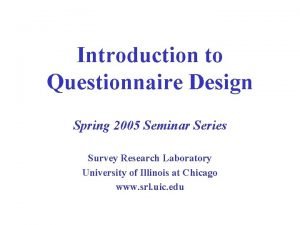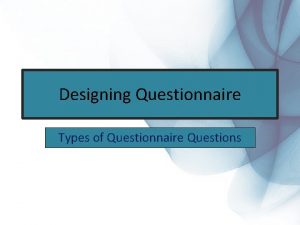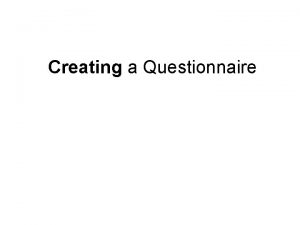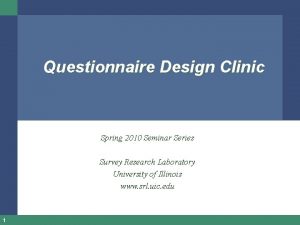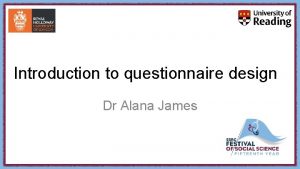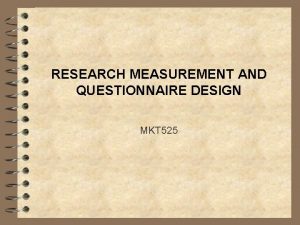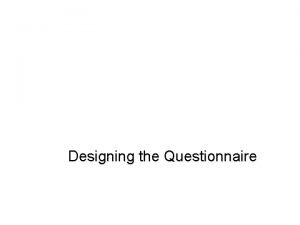Introduction to Questionnaire Design Spring 2011 Seminar Series




























- Slides: 28

Introduction to Questionnaire Design Spring 2011 Seminar Series Survey Research Laboratory University of Illinois www. srl. uic. edu 1

Open vs. Closed Questions • Open‑Ended Questions • • • Suggest no alternatives Probing Free exchange of ideas without bias Extensive interviewer training Elaborate coding schemes Expensive and time‑consuming Survey Research Laboratory 3

Open vs. Closed Questions • Closed‑Ended Questions § § § Standardized questions and answers Simple interviewer training Easy to analyze May make it too easy to answer without thinking May limit spontaneity Not best when • • § asking for frequency of sensitive behaviors there are numerous possible responses Role of initial question development and pretesting Survey Research Laboratory 4

Cognitive Steps in Answering Questions 1. Understand question. 2. Search memory for information. 3. Integrate information into summary judgment. 4. Translate judgment onto response alternatives. “Optimizing” Survey Research Laboratory 5

Cognitive Steps • Understand question. • Search memory for information. • Integrate information into summary judgment. • Translate judgment onto response alternatives. “Weak satisficing” Survey Research Laboratory 6

Cognitive Steps • Understand question. • Search memory for information. • Integrate information into summary judgment. • Translate judgment onto response alternatives. “Strong satisficing” Survey Research Laboratory 7

Factors Influencing Satisficing • Respondent motivation • Respondent ability • Task difficulty Survey Research Laboratory 8

Response Effects Explained by Satisficing • • Response order Acquiescence Non-differentiation Saying “don’t know” Survey Research Laboratory 9

Response order effects • Primacy • Recency Survey Research Laboratory 10

Response Effects Explained by Satisficing • • Response order Acquiescence Non-differentiation Saying “don’t know” Survey Research Laboratory 11

Acquiescence Form A (agree I’s version): Individuals are more to blame than social conditions for crime and lawlessness in this country. Form A (Agree I’s) Agree (I): 59. 6% Form B (agree SCs version): Social conditions are more to blame than individuals for crime and lawlessness in this country. Form B (Agree SCs) Agree (SC): 56. 8% Disagree (SC): 40. 4 100 (473) Disagree (I): 43. 2 100 (472) Survey Research Laboratory 12

Acquiescence I like going to the movies. Strongly agree Agree Neither Disagree Strongly disagree Do you like or dislike going to the movies? Like Dislike Survey Research Laboratory 13

Response Effects Explained by Satisficing • • Response order Acquiescence Non-differentiation Saying “don’t know Survey Research Laboratory 14

Non-differentiation How important is each of the following qualities for a child to have? Not Extremely important Good manners 1 2 3 4 5 6 7 Tries hard to succeed 1 2 3 4 5 6 7 Is honest 1 2 3 4 5 6 7 Is neat and clean 1 2 3 4 5 6 7 Has sound judgment 1 2 3 4 5 6 7 Survey Research Laboratory 15

Response Effects Explained by Satisficing • • Response order Acquiescence Non-differentiation Saying “don’t know Survey Research Laboratory 16

Other Issues • Double-barreled questions Question: Compared to one year ago, are you paying more, less, or about the same for your auto and life insurance? Better Question: Compared to one year ago, are you now paying more, less, or about the same for… a. auto insurance? b. life insurance? Survey Research Laboratory 17

Other Issues • Specify who, what, when, where and how Question: What is your total household income? Better Question: In 2010, what was your total household income, before taxes? Please count income from all members of your household, including wages from employment, disability, social security, and public aid Survey Research Laboratory 18

Other Issues • Specify through cues Question: During the past 30 days, did you drink any beer? Better Question: People drink beer in many places – for example, at home, at restaurants, at bars, sporting events, at friends’ homes, etc. During the past 30 days, did you drink any beer? Survey Research Laboratory 19

Other Issues Use words with singular meanings Ambiguous: How would you compare how close you are to family in your current neighborhood to how close you were in your old neighborhood? Would you say your family is closer here, further here, or the same? Clearer: Compared to your last neighborhood, do you now live closer to your family, are you further from your family, or are you about the same distance? Survey Research Laboratory 20

Other Issues • Response Options § Should be consistent with the question § Should typically be exhaustive, including every possible answer § Categories should typically be mutually exclusive (no overlap) Survey Research Laboratory 21

Other Issues • Numbering vs. Labeling § Numbers alone § Partial labeling § Full labeling Survey Research Laboratory 22

Other Issues • Constructing Response Scales § Length of response scale § Using graphic images, such as thermometers and ladders, and card sorting for complex ratings Survey Research Laboratory 23

Physical Format Checklist § Number all questions sequentially § Use large, clear type; don’t crowd § ‘White space: ’ Place more blank space between questions than between subcomponents of questions § List answer categories vertically instead of horizontally § Avoid double/triple ‘banking’ of response choices § Be consistent with direction of response categories Survey Research Laboratory 24

Physical Format Checklist (continued) § Don’t split questions across pages. If necessary (e. g. , question requires 1. 5 pages), restate question and response categories on next page § Put special instructions on questionnaire as needed, next to question § Distinguish directions from questions – be consistent Survey Research Laboratory 25

Key References To Get Started Dillman, Don. Mail and Internet Surveys: The Tailored Design Method. New York: John, Wiley & Sons, Inc, 1999. Bradburn, N, Sudman, S. and Wansink, B. Asking Questions: The Definitive Guide to Questionnaire design – for Market Research, Political Polls, and Social and Health Questionnaires. San Francisco: Jossey Bass, 2004. See also past issues of Public Opinion Quarterly Survey Research Laboratory 26

Other References Schuman, H. , & Presser, S. (1981). Questions and answers in attitude surveys. New York: Academic Press. Krosnick, J. A. (1991). Response strategies for coping with the cognitive demands of attitude measures in surveys. Applied Cognitive Psychology, 5, 213 -236. Krosnick, J. A. , Holbrook, A. L. , Berent, M. K. , Carson, R. T. , Hanemann, W. M. , Kopp, R. J. , Mitchell, R. C. , et al. (2002). The impact of "No Opinion" response options on data quality: Non-attitude reduction or an invitation to satisfice? Public Opinion Quarterly, 66, 371– 403. Survey Research Laboratory 27

Survey Intro/Cover Letter Introduction should indicate: § § § who is conducting the survey the topics to be covered in the survey an assurance of confidentiality any IRB stipulations whether you offer how long it will take depends on mode, topic, population Survey Research Laboratory 28

Ordering the Questions § Put demographic questions at the end § Leave objectionable questions (e. g. , income) for the end § First questions should be directly related to the topic as described in the introduction or advance/cover letter Survey Research Laboratory 29
 Ecisd spring break 2011
Ecisd spring break 2011 Four seasons korean movie
Four seasons korean movie Is may in spring or summer
Is may in spring or summer Introduction of questionnaire
Introduction of questionnaire Research questionnaire
Research questionnaire Questionnaire design process chpt 11
Questionnaire design process chpt 11 Questionnaire design process chpt 11
Questionnaire design process chpt 11 Oppenheim questionnaire design
Oppenheim questionnaire design Questionnaire design checklist
Questionnaire design checklist Questionnaire form and design
Questionnaire form and design Questionnaire database design
Questionnaire database design Funnel approach questionnaire
Funnel approach questionnaire Quantitative questionnaire design
Quantitative questionnaire design Principles of questionnaire design
Principles of questionnaire design Seminar presentation introduction
Seminar presentation introduction Left driving countries
Left driving countries Introduction to seminar
Introduction to seminar Debate points
Debate points Maclaurin series vs taylor series
Maclaurin series vs taylor series Balmer series lyman series
Balmer series lyman series Taylor series of composite function
Taylor series of composite function Deret maclaurin
Deret maclaurin Ibm p series servers
Ibm p series servers Shunt-series feedback
Shunt-series feedback Series aiding and series opposing
Series aiding and series opposing Arithmetic series formula
Arithmetic series formula Pertanyaan tentang design
Pertanyaan tentang design Spring framework introduction
Spring framework introduction Javaero
Javaero
